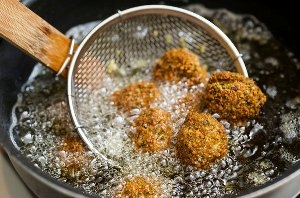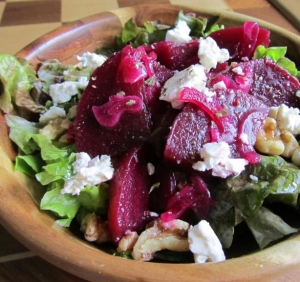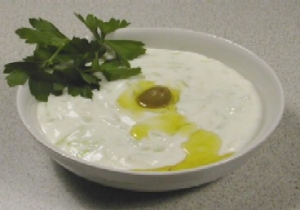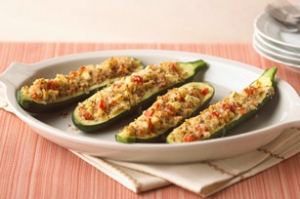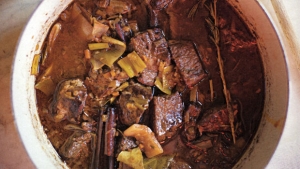There are differences among fats, of course, but with trans-fats in full retreat and lard and butter making comebacks, the whole fat-eating thing is starting to make some sense. Of course, the key word is moderation. You can eat fat as long as it’s high quality and you don’t eat it to the exclusion of plants.
That’s one reason you shouldn’t reject deep-frying at home; I do it about once a month. The second reason is that you know you love it. The third is that it can be fast and easy. The fourth is that you can deep-fry plants. (And anything else.)
Frying is thought of as messy, but this can be mitigated by the simplest of measures: using a pot that is heavy, broad and deep, like a well-made stockpot. Choose this, add a fair amount of oil and the process is simplified and neat.
Which oil? How much? Since most deep-frying is done at around 180 degrees Celsius, this whole notion that olive oil is inappropriate for frying is nonsense; it smokes at 190 (and smoking isn’t the end of the story, either). So olive oil — especially “pure,” which is a step below extra-virgin and in theory less expensive — is a fine option, especially for something in which you’d like its flavor, which could include any of the recipes here.
Unless, that is, you’re seasoning tempura with soy sauce, in which case you might choose peanut oil, which is as flavorful as olive oil, but obviously different. The third excellent option is grapeseed oil, which is as close to neutral as you can find.
None of these is as inexpensive as vegetable oil, or soy, or corn or Wesson. And if you don’t have problems with chemical extraction, you might choose one of them; they are, after all, what is used for nearly all commercial deep-frying. If, however, you can afford it and you want the best possible frying experience, use one of those three mentioned above, or at least a cold-pressed neutral oil like safflower or sunflower.
Money is an issue, since on the face of it, frying isn’t cheap. When it comes to the “how much” question, I’d say around 6 cups is probably enough in most cases.
But more is generally better, and you can reuse the oil quite a few times for deep-frying, stir-frying or sautéing, as long as you strain out most solids — and you need not be fanatic about this; a quick run through a strainer is fine — and keep it in the refrigerator. (You might consider keeping oil you’re not using in the near future in the refrigerator anyway; rancidity comes from heat and light and it’s nasty. If you have an old bottle of oil sitting around in your kitchen, smell it; you’ll probably throw it away.)
The goal of frying is to crisp the outside perfectly and cook the inside just enough, while keeping the whole package from absorbing more than a bit of oil. Most of this happens magically, as long as you follow the rules, which I’ll get to in a second. There are three or four levels of protection you can give the interior, and all of them become satisfying crusts — again, as long as everything goes right.
The first layer of protection is the stuff itself: you allow the outside of the food you’re cooking to become the crisp part (that’s like a French fry, or falafel or “naked” fried chicken). Then there’s the second layer: a light dusting of cornmeal, flour or the like (I like this with fried squid or fried chicken, especially when seasoned heavily with black pepper). Then a fluffy coating, like tempura or a doughy, pancake-like batter (the latter, it seems to me, is often — perhaps usually — overkill). And finally, the old flour, egg and bread crumb treatment, which is, well, yum.
They’re all pretty much appropriate for anything. You choose the food you want to fry, you choose the coating, you follow these general instructions and it’ll work.
Start by putting at least two inches of oil in a heavy and, as I said, deep pot. Less than two inches and you may not be deep-frying; it’ll work, but you might have to turn the food more often, it might stick to the bottom a bit and it might cook less evenly.
Turn the heat to medium or medium-high and go about your business. Part of that business might be finding a thermometer, because you want that oil to be between 350 and 365 in almost every instance. The heavy pot will help keep that temperature stable.
You don’t have to have a thermometer, though, because there are a couple of other ways to know when the oil is ready. It’s just about right when a pinch of flour sizzles without burning immediately; that’s not super-accurate, but if you then add a single piece of food and it first sinks a bit and then immediately rises to the top, the oil is perfect. If it sits on the bottom like a flounder, the oil isn’t hot enough; if it doesn’t sink at all the oil is too hot. The oil is also too hot if it’s smoking.
Add your food in batches and don’t crowd; you do not want the temperature to plummet, nor do you want the pieces of food nestling against one another. (Though it’s fine if they bump.) You may or may not have to turn the pieces, but that’s easy, because they’ll be floating and they won’t stick. Remove them with a slotted spoon, tongs or spider; you’ll know when they’re done because the color will be evenly gorgeous.
Take it slow and either eat the food as it comes out of the fat (you can drain on paper towels or, if you want to be fancy, a cloth napkin) or keep it warm for as little time as possible in a low oven. Myself, I like to fry when people are standing around eating the food as fast as I can produce it; that is really fun. And good for you.
By Mark Bittman

